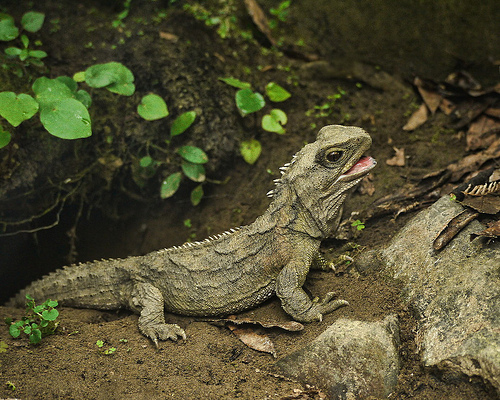Tuataras are not lizards… but they are reptiles!
- A tuatara is a species of reptile native to New Zealand and its nearby islands, and are the only extant members of the order Rhynchocephalia.
- The scientific name of a tuatara is Sphenodon, from the family Sphenodontidae, and there are two living species.
- Tuataras can grow up to 70 to 80 centimetres (28 to 31 inches) in length, and they can weigh up to 0.6 to 1 kilogram (1.3 to 2.2 pounds).
- ‘Tuatara’ is a native Maori word, which in English can be translated as ‘spines on the back’, referring to the crested spikes on the animal.
- The tuatara was first classified in 1831 by the British Museum after studying the reptile’s skull, and it was classed as a lizard, however, in 1867 this was determined to be inaccurate and was changed.
Tuatara
Image courtesy of Sid Mosdell/Flickr
- The skin of tuataras can be grey, green or brown in colour, which is shed many times and the reptile also features a spiny back and three eyes, one of which sits on top of its head.
- Tuataras have a life span that ranges from 60 to 100 years, and they are preyed on by rats, pigs and cats and other introduced species.
- The diet of tuataras typically includes insects, frogs, spiders, lizards, young birds and eggs, and they live in burrows, generally venturing out at night.
- Tuataras are mainly found on isolated islands, although they are being reintroduced to mainland New Zealand, and there has also been a concerted effort to protect them, as their numbers are dwindling due to habitat loss, and the eggs and young are very vulnerable to introduced predators.
- A female tuatara lays up to 19 eggs approximately once every four or five years, although the eggs can take up to 15 months to incubate, and the incubation temperature determines the gender of the hatched reptile.
Bibliography:
Tuatara, 2014, A-Z Animals, http://a-z-animals.com/animals/tuatara/
Tuatara, 2014, San Diego Zoo, http://animals.sandiegozoo.org/animals/tuatara
Tuatara, 2014, Wikipedia, http://en.wikipedia.org/wiki/Tuatara







